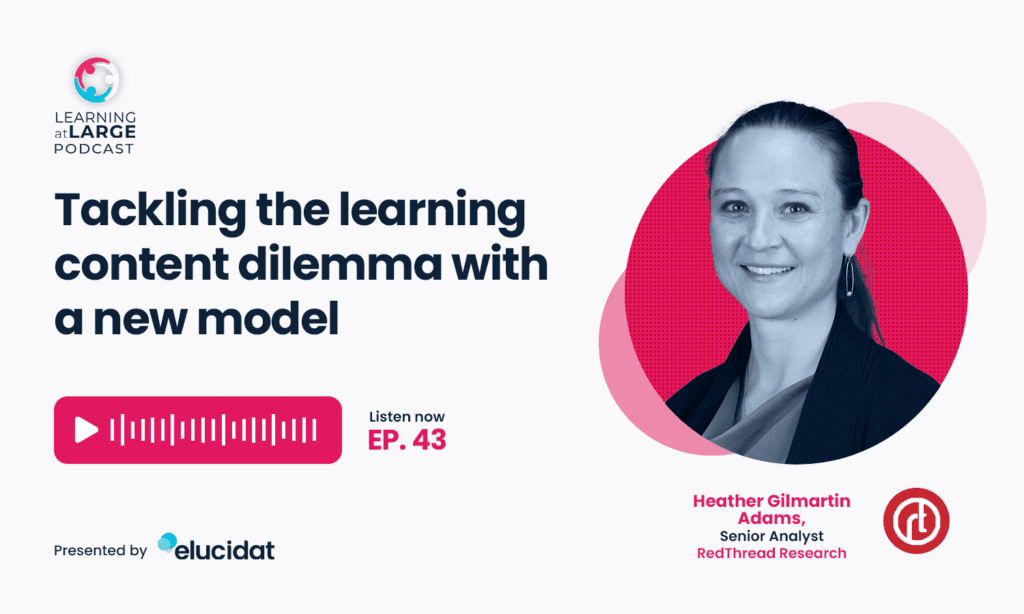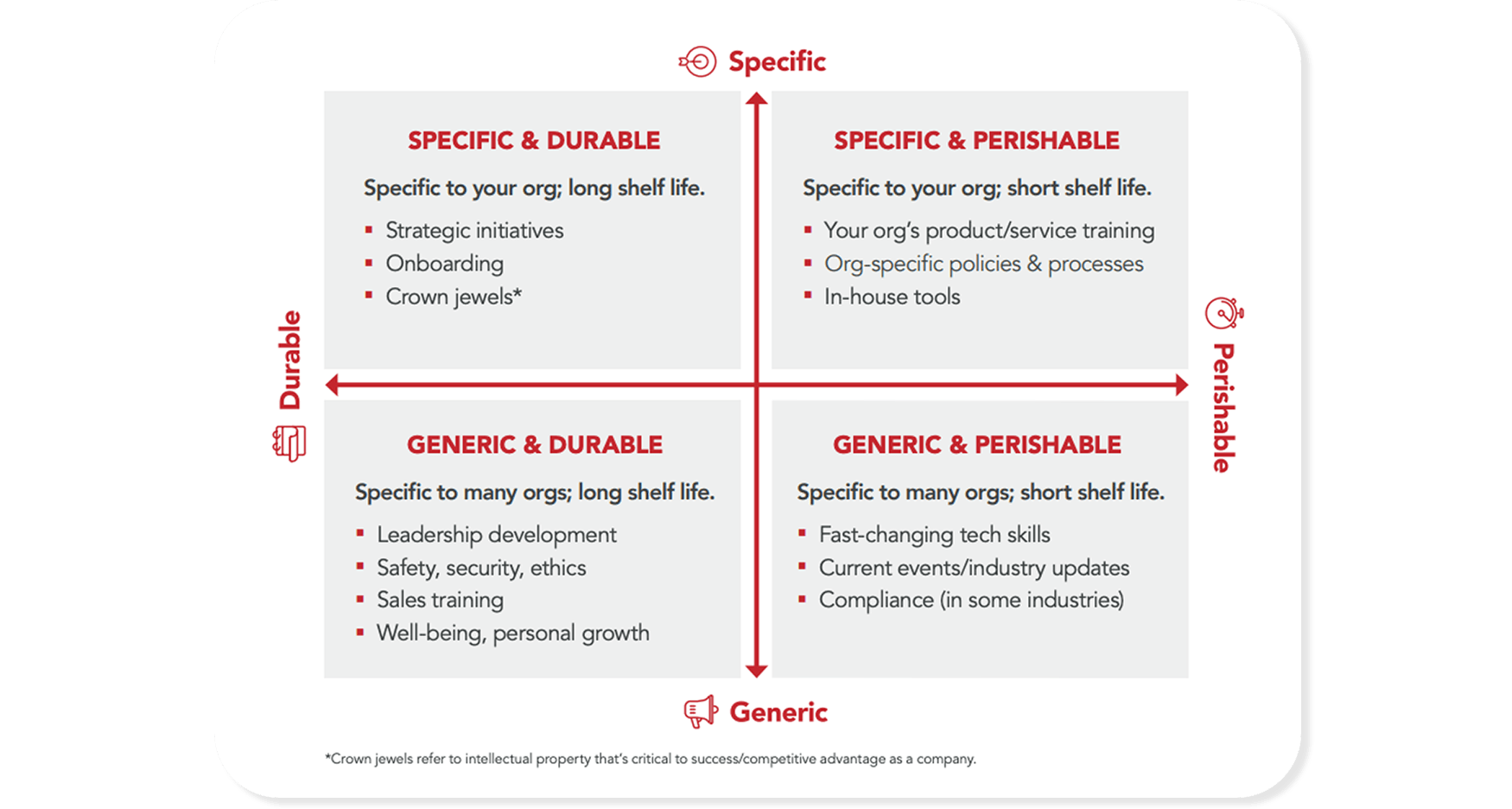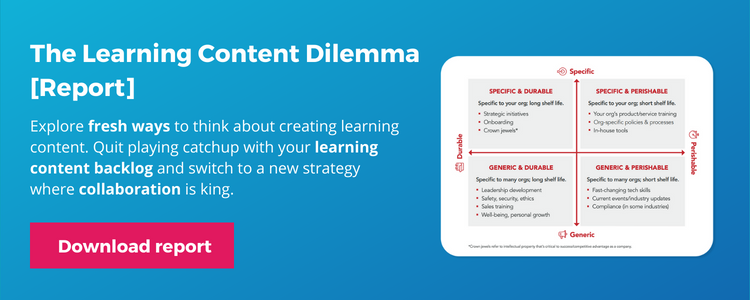Tackling the Learning Content Dilemma: Heather Gilmartin Adams
Faced with increasing training demand and more strategic responsibilities than ever before, L&D is feeling the pressure. Hear how Heather Gilmartin Adams, Senior Analyst at RedThread Research, is helping L&D teams understand that they don’t have to tackle the learning content dilemma alone. Find out why this requires a big mindset shift and a new model. Discover how taking a focused approach and deputizing learning content creation will deliver real value.

Top tips for a new model for learning content creation
Don’t have time to listen now? Here are some key themes from Heather’s research:
- Recognize you don’t have to do it all: The first step in tackling the learning content dilemma is acknowledging the key issue. L&D teams can’t do everything, and neither should they.
- Move from controller to consultant: Trying to create and control all learning content clearly isn’t working. L&D need to shift from doing or controlling, to empowering and deputizing learning content creation.
- Get focused with a new content model: Differentiate your learning content based on its specificity and durability. Use this model to target L&D involvement and deliver real value.
- Deputize content creation: Set up systems and processes that empower your organization’s experts to create effective learning content.
1. Recognize you don’t have to do it all
The current pressures faced by L&D are brought into sharp focus by Heather’s research on the learning content dilemma. With the huge amount of content out there, employees are struggling to find what they need. While L&D are trying to support people to access the right learning at the right time, this is only one part of their job. New strategic responsibilities are taking up an increasing part of their time.
L&D teams simply can’t do everything. And, Heather says, they don’t need to.
“This is the dilemma. On the one hand, L&D functions are responsible for helping employees navigate this massive ocean of content to find what they need, when they need it. On the other hand, they’re being asked to do a lot more. So that helping employees navigate piece of their responsibility is a smaller portion of the pie… L&D in many organizations is saying: ‘We just can’t do it all’. And this research found they don’t have to. L&D functions don’t have to try and control and manage all learning content. There are other options.”
2. Move from controller to consultant
If learning content is going to have an impact, L&D needs a mindset shift. You need to move from creating and controlling all learning to enabling your employees to access the development that they need, when they need it.
For Heather, this means stepping back and thinking more strategically. By setting up systems and processes, you can guide and empower employees to take control of their own learning.
“That’s a big shift in terms of how L&D functions think about their own role. And it means stepping back and feeling like you’re letting go of control, when in fact, what you’re doing is stepping into more of a leadership role. It’s more of a guiding and consulting and big picture strategic role. How long have L&D functions been saying: ‘We want a seat at the table’? Taking a seat at that table means letting go of some of the more tactical stuff.”
3. Get focused with a new content model
Of course, this mindset shift needs to be backed up with practical tools. And that’s where RedThread Research’s new learning content model come in. It enables you to quickly and easily see where L&D’s effort and investment should be focused.
The model differentiates learning content based on two factors: specificity and durability. Is the content specific to the organization or generic? Is it durable or perishable? The role L&D should play depends on where the content fits into this matrix. Heather is clear that, in most cases, it isn’t creating the content. It’s helping employees filter generic content, enabling others to produce content and creating consistency, quality and equity across functions.
“The L&D function’s role and focus needs to change depending on the category of content you’re thinking about – depending on which quadrant in the model you’re in…The fourth quadrant is specific and durable. This is content that’s unique to your organization, but doesn’t need to be updated as frequently. [For example], company values, culture, diversity, equity, inclusion and belonging. And here’s where maybe the L&D function does want to take a bit more of a hands-on role in creating content. Because this is the content that’s aligned with really big strategic organizational goals, change initiatives, the company’s competitive advantages.”

4. Deputize content creation
Every L&D team knows that successfully involving their internal experts is critical to producing successful learning content. There’s a huge amount of knowledge and expertise in your organization. It’s up to you to help them share it.
Heather is clear that enabling others play their part in collaborative content creation, doesn’t mean L&D letting go of all control. Having the right strategic oversight is key to producing quality learning at scale.
“The L&D functions job is to say: ‘You’re the experts. Here are some ways that we’ve set up that make it really easy for you to share your expertise’. It’s literally deputizing the actual content creation and maintenance to others in the organization…The way that a number of people talked about it was almost like being consultants. They set themselves up and marketed themselves within the organization as the people who know how to create great content, the people who have the systems and the templates, and the things that can help other people in organization create great content easily.”
A quick recap
With training demand at an all-time high and increased strategic responsibilities, L&D are facing a learning content dilemma. Heather’s research has identified four strategies you can use to tackle it.
- Start by recognizing that you can’t do everything, and neither should you.
- Make a mindset shift from doing or controlling, to empowering and deputizing learning content creation.
- Use a new learning content model that enables you to get focused so you can deliver real value.
- Empower anyone in your organization to create effective learning content.
Want to find out more? Check out the full podcast and listen to our panel discussion of Heather’s research.
About Heather
With over 10 years’ experience in a variety of organizations, Heather joined RedThread Research as a Senior Analyst in 2020. Her research focuses on topics like career development, performance management, people analytics and employee experience and makes connections between data, ideas and stories.
You can find out more and get connected with Heather on LinkedIn.
On Heather’s reading lists
Find out what recent reading has informed Heather’s thinking.
Essentialism: The Disciplined Pursuit of Less, Greg McKeown
This book reminds Heather to focus on what really matters. It isn’t about doing more in less time, but getting only the right things done.
Subtract: The Untapped Science of Less, Leidy Klotz
Klotz’s work highlights that our minds tend to add before taking away. Heather finds this book’s approach to simplification as useful in her day-to-day life as her work.
The Art of Gathering: How We Meet and Why It Matters, Priya Parker
This book sets out a human-centered approach to gathering that creates meaningful, memorable experiences. Heather is interested in how this can help us be intentional about how we bring people together for different purposes.
Looking for more reading tips? Check out our book blog.
Join the conversation!
We’d love to hear your thoughts on our podcast, so feel free to get in touch on Twitter @Elucidat with any questions or queries. You can also email Kirstie, our podcast host, at kirstie.greany@elucidat.com. As always, don’t forget to subscribe to Learning at Large in your favorite podcast app and leave us a 5-star rating if you enjoyed it. Thank you for joining us, and see you next time.
Want to hear more from Heather and other learning experts? Watch the webinar panel discussion recording to explore how to empower your people with a new model for L&D. Or download the full report and explore this model and how it can help you beat the learning content dilemma.
